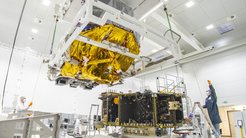PLATO Payload Integration Marks Key Step Toward Launch
The space probe’s optical bench is now connected to the service module. Starting in 2027, the European mission will search for Earth-like worlds outside our Solar System.
The European exoplanet mission PLATO, which will be launched into space at the end of next year, has reached an important milestone. The optical bench with its 26 cameras has now been assembled in the clean rooms of the aerospace company OHB System AG in Oberpfaffenhofen (Germany). The cameras are the eyes of the mission. They will enable PLATO to peer at a total of a quarter of a million stars in the Milky Way and detect exoplanets in the stars’ brightness fluctuations. A key part of the mission's scientific ground segment, the PLATO Data Center (PDC), is currently being set up at the Max Planck Institute for Solar System Research (MPS) in Göttingen (Germany). The PDC will process the flood of data delivered by PLATO's 26 cameras to deliver the PLATO science data products. The University of Göttingen is also contributing as a mission consortium member. The overall responsibility of the PLATO mission is under the Institute of Space Research at the German Aerospace Center (DLR).

Is our Earth unique, or are there similar planets orbiting stars like the Sun? To answer this question, ESA’s PLATO mission will be launched into space at the end of 2026. From 2027 onward, PLATO will search for planets orbiting distant stars among a vast catalogue of potenital candidates. Its special focus will be on detecting Earth-sized planets around Sun-like stars. To scan a large region of the sky with high sensitivity, PLATO is equipped with 26 cameras that can detect subtle drops in stellar brightness caused by a planet transiting its star. Among these, two fast cameras will help keep PLATO precisely aligned and on course.
A key aspect of PLATO is its ability not only to detect planetary transits but also to measure the oscillations of tens of thousands of Sun-like stars. These stellar oscillations, combined with follow-up observations from Earth-based telescopes, will allow us to precisely determine fundamental stellar and planetary properties, including radii, masses, and ages. “Accurate stellar parameters are essential for correctly interpreting planetary transits, characterizing exoplanets, and understanding the architecture of planetary systems. This will allow us to determine which planets are habitable, i.e., life-friendly worlds,” explains Laurent Gizon, Managing Director of the MPS and professor at University of Göttingen. “PLATO will significantly advance both the field of stellar physics and our understanding of exoplanetary systems”, he adds. “The ground-based follow-up observations for PLATO will be an exciting opportunity for the characterization of nearby sun-like stars”, remarks Ansgar Reiners, professor at the University of Göttingen.
From Oberpfaffenhofen via Noordwijk and Kourou into space
Over the past few months, PLATO's 26 cameras have been mounted on the camera platform, known as the optical bench, in the clean rooms of OHB System AG. In mid-June, the optical bench was successfully connected to the space probe's service module. The service module contains all the components necessary for PLATO's operation. A few final tests are still to be carried out in the coming weeks before PLATO changes locations. At ESA's Space Research and Technology Centre (ESTEC) in Noordwijk (Netherlands), the solar modules and sun protection panels will then be installed and the complete space probe prepared for its journey into space. The launch is scheduled for December of next year from Europe’s spaceport in Kourou, French Guiana.
“The integration of the 26 cameras is a crucial step in the development of the mission. The PLATO spacecraft is now almost complete, and launch is just around the corner,” says Laurent Gizon. In parallel, preparations for the mission’s ground segment are in full swing at several institutions in Germany. The MPS team of 13 scientists and engineers has significantly contributed to developing the algorithms that will process the data and is leading the development and operation of the PLATO Data Center, a distributed infrastructure that will analyze the mission’s data across Europe. “At the PLATO Data Center, the observational data will be processed, translated into scientific data products and validated, for use by the European scientific community,” explains Gizon. The data volume is expected to total tens of petabytes by the end of the mission.












